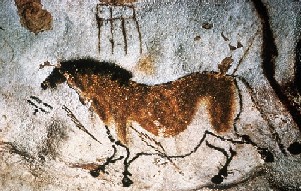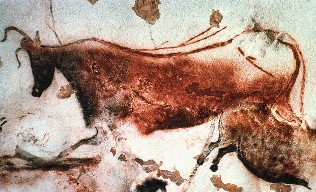

Deep within the
shadowy depths of a rocky cave, an artist was hard at work.
He had been deep inside the cave for days, and its jagged walls were
slowly being covered with looming animal shapes.
The artist carried his colors in hollow bones, daubing it onto the walls
with small pads of fur. He worked
in silence, creating herds of fat deer in hopes of a successful hunt.
Painting the Caves
Painted Beasts and Famous Caves
How Do We Know That?
Some of the world’s oldest art has been found deep
within stone caves in southern Europe. Scientists
believe that a prehistoric species of humans called the Cro-Magnons are
responsible for creating the fascinating paintings.
Cro-Magnon Man
The Cro-Magnon race existed from about 40,000 to 10,000 years ago.
They lived during a period of time called the Ice Age, when Earth was
very cold and enormous glaciers of ice covered much of the land.
During this time, the Cro-Magnons lived mostly in what are now northern
Spain and southern France.
These prehistoric people were hunter-gatherers who moved
from place to place, following the food. They
were different from previous humans, like the Neanderthals, because they had
more advanced thinking. The
Cro-Magnons figured out how to survive the cold climate by making warm fur
clothing, sharp flint blades, and huts of mammoth bones and skins.
Most importantly, the Cro-Magnons learned how to draw a symbol to
represent a real object. This discovery led them to create art.
Cro-Magnon art tools have been found in many painted caves.
Explorers have found the remains of fat-burning lamps and of rough
scaffolding that was used to reach high places.
Prehistoric paints were made of red, yellow, brown, and gray clay.
Soot from their fires colored black paint.
Liquid paint was created when the pigments were ground into a fine powder
and mixed with melted animal fat. These
mixtures were often stored in hollow animal bones.
The Cro-Magnons also made something like crayons by blending the pigment
powder into wax and then rolling the mixture into sticks.
 Cave Painting of "Chinese Horse" (ca. 13,000 BC) Lascaux, France |
The Cro-Magnons had different painting techniques that
changed over the years. They drew
on cave walls with their rough crayons or painted with brushes made from tufts
of animal hair or shredded plant stalks. Sometimes
they painted with their fingers. They even spray painted by blowing liquid paint through a
hollow bone or spitting it onto the cave’s walls.
Painted Beasts and Famous Caves
Prehistoric painters filled their caves with animal images.
They painted horses, bears, hyenas, woolly rhinos, mammoths, bison,
cattle, lions, deer, panthers, and mountain goats.
Their rough pictures were usually heavily outlined, and sometimes the
bumpy surfaces of the cave walls were used to make pictures shapely.
Today we think that the Cro-Magnons may have painted animals as a ritual
to ensure successful hunting and animal fertility. The Cro-Magnons hardly ever painted humans.
If people appear in the cave paintings, they are usually only stick figures or handprints.
 Cave Painting of Cattle (ca. 17,000 - 12,000 BC) Lascaux, France |
The world’s oldest cave paintings were discovered in
1994 in a cave in Avignon, France. This
cave contains more than 300 detailed animal paintings that have been there for
32,000 years. Another famous French
cave found in 1940, Lascaux, boasts thirteen different painting styles.
Scientists believe that these style differences show that the Cro-Magnons
painted in this cave for nearly a thousand years.
Spain’s most famous cave paintings were discovered as early as 1868, in
Altamira.
How Do We Know That?
Perhaps the most unusual painted cave was discovered in July, 1991, by a
French scuba diver named Henri Cosquer. Although it contains paintings of cave bears, panthers, and
woolly rhinos, few people have seen the inside of Cosquer Cave because its
entrance is far beneath the surface of the Mediterranean Sea.
The cave was not under water when the Cro-Magnons were
using it. It would have been
flooded near the end of the Ice Age, when the Earth warmed and the glaciers
melted, causing the sea level to rise nearly 300 feet.
Top of Page